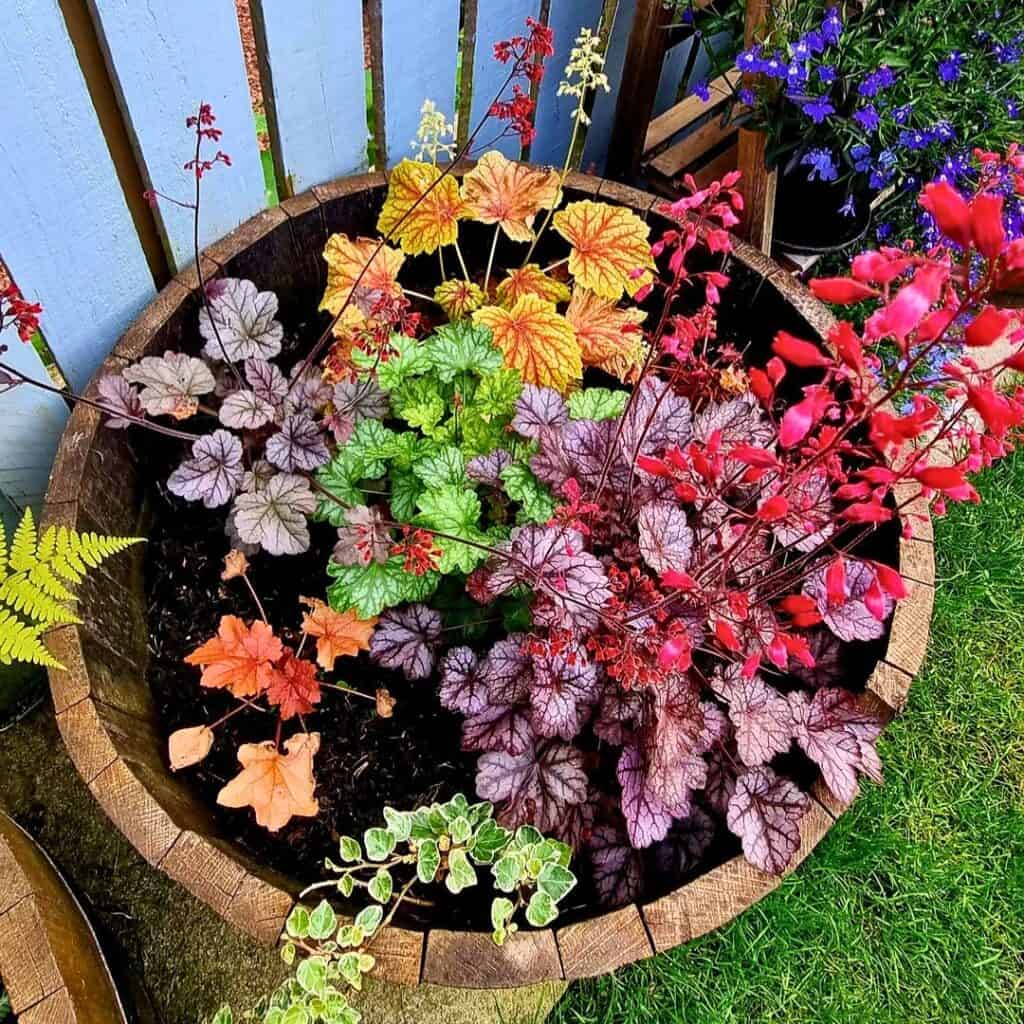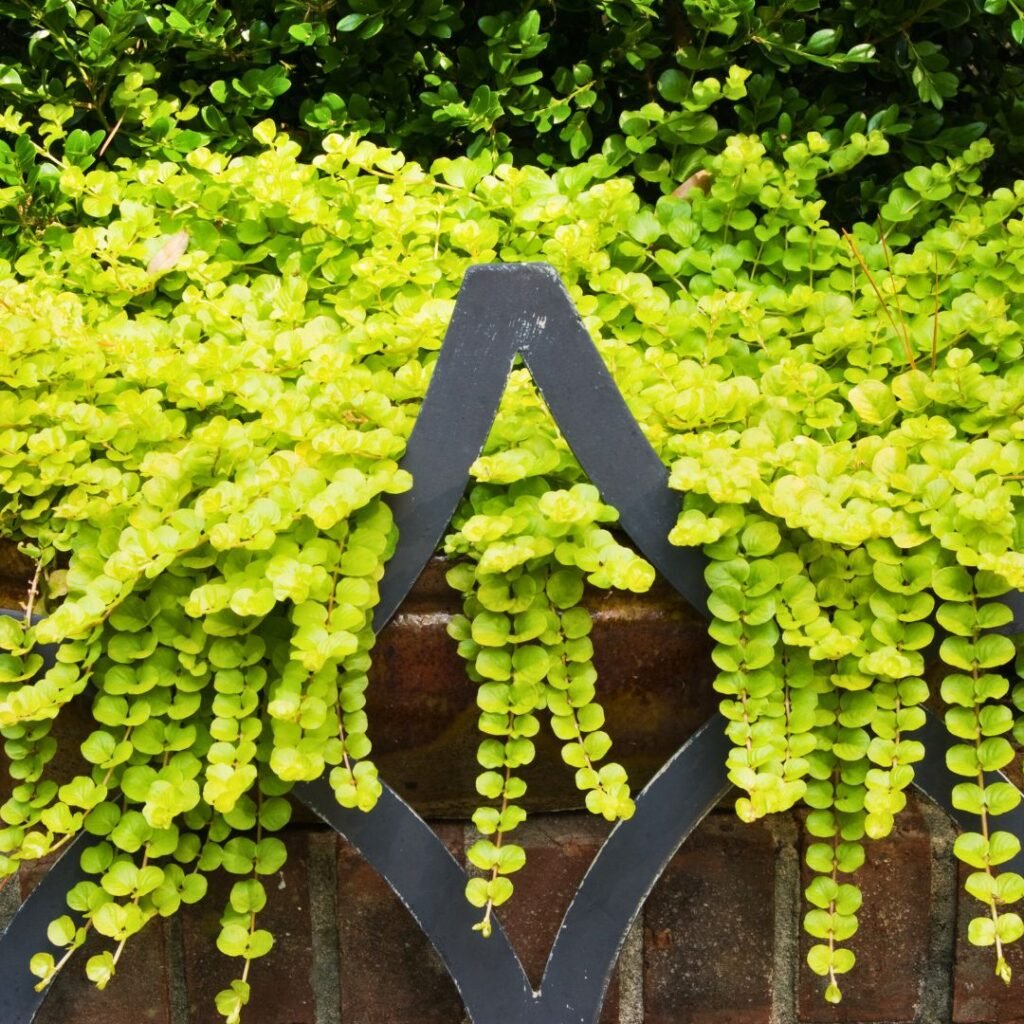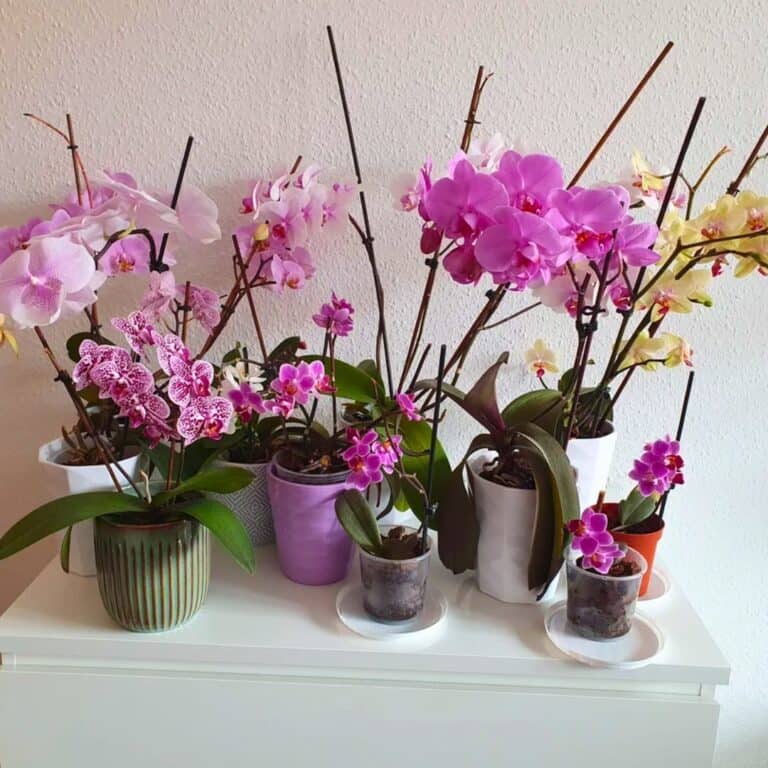Top 10 Flowering Ground Covers for Shady Gardens
I’ve always loved discovering plants that can light up those stubborn shady spots where grass just gives up.
Shady gardens might seem a little gloomy at first, but with the right flowering ground covers, you can really bring them to life.
You can turn dim corners into lush, blooming spaces with the right mix of low-growing plants. It’s honestly more fun than you’d think.
In this article, I’ll share my favorite flowering ground covers that don’t mind the shade and keep looking good through the seasons.
I’ll show you how each one adds texture, color, and—maybe best of all—easy care to your garden.
Please note: Simplify Plants is reader-supported. As an Amazon Associate, I earn from qualifying purchases made by our readers with no extra cost added to you all! Some links in the post are affiliate links and I get a commission from purchases made through links in the post.
1) Ajuga (Bugleweed)

I’m a big fan of Ajuga (or Bugleweed) when I need a pop of color in the shade. It hugs the ground and spreads fast, making a thick carpet of leaves that can be green, bronze, or even purple.
In spring, Ajuga sends up short spikes of blue or violet flowers, which are a magnet for bees and pollinators. The flowers look especially nice against the dark foliage.
Ajuga is super easygoing—it handles shade, part sun, and even poor soil. It’s also great for keeping weeds at bay since it covers bare ground so well.
I use it along paths, under trees, or between stepping stones. It fills in gaps without much fuss, and once it’s settled, I really only trim it if it gets too adventurous.
For small spaces, I just plant a few clumps about a foot apart and let them do their thing. In a season or two, you get a lush, low-maintenance carpet that keeps its color all year.
2) Liriope muscari (Lilyturf)

Liriope muscari, or Lilyturf, is one of my top picks for shady areas where grass just refuses to cooperate. It forms neat clumps of grass-like leaves that stay green most of the year, adding texture and a bit of color even when nothing else is blooming.
In late summer, you’ll see small purple or lavender flower spikes rising above the foliage, which later turn into shiny black berries that stick around into fall. It’s a subtle touch, but I think it adds a lot.
Liriope does well in partial to full shade, but it can handle a bit of sun too. It’s not picky about soil as long as it drains well, and once it’s established, you barely have to water it unless there’s a dry spell.
I like planting it as a border along paths or under trees—it’s also great for slopes since the roots help hold the soil. The dense foliage keeps weeds in check, which is always a win.
To keep things tidy, I cut back the old leaves in early spring before new growth starts. It spreads slowly, so you don’t have to worry about it taking over.
There are a few varieties, including some with variegated leaves. Mixing green and striped types makes for a nice contrast.
Because it’s tough, evergreen, and low-maintenance, Lilyturf is one of those plants I always recommend for shaded spots. It just quietly makes everything look better.
3) Vinca minor (Periwinkle)

Vinca minor (or Periwinkle) is such a classic for shady corners. It’s a low-growing evergreen that spreads easily, creating a shiny green mat that looks neat year-round.
In spring, you get these small blue or violet flowers that brighten up the darkest spots. They’re not showy, but there’s something charming about them.
I like that Periwinkle doesn’t get tall, so it’s perfect for covering ground under trees or by walkways. The leaves stay green through the winter, which keeps things looking fresh.
It grows best in partial to full shade and likes well-drained soil. I water it a bit when it’s new, but once it’s settled in, it can handle short dry spells.
Periwinkle does spread quickly, so I trim the edges now and then to keep it from wandering too far. It’s easy to keep in check with a little pruning.
It’s super handy for spots where grass won’t grow, especially on slopes and shady borders where it helps with erosion.
Vinca minor just fits in with so many garden styles. Whether it’s near ferns, hostas, or shrubs, it ties everything together and doesn’t ask for much.
If you want a reliable, low-maintenance plant for shade, Periwinkle’s hard to beat.
4) Sweet Woodruff (Galium odoratum)

Sweet Woodruff is one of those plants that quietly makes shady spots feel special. The small white flowers and soft green leaves form a thick, tidy carpet that looks good all season.
It does best in moist, well-drained soil and likes partial to full shade. When it gets warm, the leaves release a sweet scent—I can’t help but run my hand over them just to catch the fragrance.
Sweet Woodruff spreads by creeping roots, so it fills in bare areas under trees or along paths pretty quickly. I just trim the edges once or twice a year to keep it where I want it.
In spring, it puts out clusters of tiny white blooms that last for weeks. The flowers attract small pollinators, which brings a little extra life to those quiet corners.
Even after the flowers fade, the green leaves keep things looking lively. I use it as a living mulch around shrubs or taller perennials—helps keep weeds down and holds moisture in the soil.
Once it’s established, it doesn’t need much care besides a bit of water during dry spells. It’s soft and low, so it works well along walkways or under benches, where you can enjoy its texture and scent.
I like pairing it with ferns or hostas for a calm, natural vibe. If I want more, I just divide the plants in spring or fall—they transplant easily and bounce back fast.
Sweet Woodruff may be small, but it’s a dependable, fragrant ground cover that brings a lot of charm to shaded gardens.
5) Lamium maculatum (Dead Nettle)

Lamium maculatum (or Dead Nettle) is one of my go-tos for brightening up shady spots with almost no effort. The leaves have these cool silver or white markings that stand out, even when the plant isn’t blooming.
It grows low and spreads quickly, forming a soft carpet that’s perfect for filling gaps under trees or along shaded paths. It stays neat on its own, so I don’t have to fuss over it much.
Dead Nettle blooms in spring and early summer, showing off small pink, purple, or white flowers. Bees and other pollinators seem to love them, which adds some gentle movement to the garden.
It’s easy to care for, tolerating different soil types, and once it’s settled, it can even handle dry shade. I’ll water it during really dry spells, but otherwise, it’s pretty hands-off.
Since it spreads fast, I’ll trim the edges if it starts getting a little too bold. It’s not super aggressive, but a bit of maintenance keeps it balanced.
I like mixing Lamium with hostas, ferns, or heucheras—the silver leaves really make dark areas feel brighter.
If you’re after a low-maintenance, shade-loving ground cover, this one’s a solid choice. It’s hardy, adaptable, and interesting through both leaves and flowers.
6) Epimedium (Barrenwort)

Epimedium, or Barrenwort, is a quiet superstar in shady spots where other plants just can’t keep up. It’s a low, spreading perennial that adds soft color and texture under trees or along shaded paths.
The heart-shaped leaves often come up with a reddish tint in spring and turn green as the season goes on. In fall, they sometimes shift to bronze or red, which is a nice bonus.
Epimedium blooms in spring with delicate flowers hanging from thin stems. Depending on the variety, you’ll get white, pink, yellow, or purple blooms—they’re small and airy, never overwhelming.
It forms a dense ground cover over time, blocking weeds and holding moisture in the soil. It spreads slowly, so it’s easy to keep in check.
Epimedium prefers well-drained soil and shade, but once it’s established, it’s surprisingly drought-tolerant. I water it during dry spells, but it’s not needy.
I trim back old leaves in early spring to make way for new growth. That’s about it for maintenance.
It pairs really well with ferns, hostas, and heucheras—the fine texture of Epimedium leaves looks great next to bolder plants.
With its low maintenance and graceful look, Epimedium has become one of my favorite ground covers for shady areas. It fills in bare spots and adds a gentle beauty.
7) Heuchera (Coral Bells)

Heuchera, or Coral Bells, is a personal favorite for adding color and texture to shady spaces. The leaves come in all sorts of shades—green, purple, silver, bronze—so there’s something for everyone.
These plants grow in small clumps, making a tidy ground cover that looks good year-round. They like partial to full shade and well-drained soil; too much sun can fade their color, so I keep them out of the harshest light.
Heuchera blooms in late spring or early summer, sending up slender stems with tiny bell-shaped flowers. Hummingbirds and pollinators seem to love them, which livens things up a bit.
They’re pretty low-maintenance. I water them during dry spells but avoid soggy soil. Every few years, I divide the plants to keep them healthy.
There are so many varieties, each with its own leaf color and pattern. I like mixing different types together for extra contrast along garden paths or in shady beds.
Heuchera pairs nicely with hostas, ferns, and astilbes. Together, they create a soft, layered look that’s perfect for woodland or border gardens.
Even in winter, the leaves often stay attractive, especially if you live somewhere mild. Coral Bells might be small, but they really make a shady garden pop.
8) Pachysandra terminalis (Japanese Spurge)

I’m a big fan of Pachysandra terminalis—most folks know it as Japanese Spurge—for those shady corners in my garden. It stays green all year and slowly forms a thick carpet that keeps weeds in check.
This plant really prefers partial to full shade. It likes moist, well-drained soil, though I’ve noticed it survives dry patches once it’s settled in. Still, it always looks fresher with regular water.
The leaves are shiny, deep green, and give the garden a neat, polished vibe. Early spring brings small white flowers—nothing too dramatic, but they add a gentle touch of color.
Deer and rabbits mostly ignore it, which is honestly a relief. If it wanders too far, I just trim it back and it’s good as new.
When planting, I space the pieces about 8 to 12 inches apart so it fills in evenly. With a bit of patience, it forms a dense, tidy mat that sticks around all year.
Japanese Spurge works great under trees or along shaded borders where grass just refuses to grow. It’s one of those plants that quietly keeps things looking cared for, and I barely have to think about it.
9) Tiarella cordifolia (Foamflower)

I really enjoy Tiarella cordifolia, or Foamflower, for its soft look and how easy it is to grow. It does well in shady spots where lots of plants struggle.
Its small white or pinkish blooms show up in spring and brighten those dark garden corners. The heart-shaped leaves make a dense mat that helps keep weeds at bay.
The foliage often has dark veins or patterns, so there’s interest even after the flowers are gone. In fall, the leaves sometimes turn bronze or reddish, which is a nice bonus.
Foamflower likes moist, well-drained soil rich in organic matter. It prefers partial to full shade, so it’s perfect for under trees or along shaded paths.
I water it regularly during dry spells, just to keep things lightly damp. It spreads slowly by short runners, so it stays pretty tidy and doesn’t take over.
I often pair it with hostas, ferns, or heucheras for a layered, natural look. The flowers attract pollinators like bees, which always brings a bit of life to the shade.
It seems happiest in cooler climates, but if the soil stays moist, it can handle a bit of heat. This hardy perennial comes back every year with almost no effort.
I just trim away old leaves in early spring to make room for new growth. For small gardens, Foamflower works well as a border plant or ground cover around shrubs.
Its soft texture and neat habit make it one of my favorites for shaded beds.
10) Creeping Jenny (Lysimachia nummularia)

I love how Creeping Jenny lights up shady spots with its tiny round leaves and golden-green color. It forms a soft, spreading carpet that fills in empty spaces so nicely.
When I plant it near paths or under trees, it just takes off. This plant thrives in partial to full shade, though a bit of morning sun won’t hurt.
I’ve found it does best in moist, well-drained soil. If things get too dry, the leaves can lose their color or start to wilt, so I try to keep an eye on that.
Creeping Jenny stays low—usually under two inches—but it spreads fast. I trim it back if it starts to crowd other plants, and it’s great for covering bare soil or softening the edges of beds.
In late spring or early summer, it pops out small yellow flowers. They’re not showy, but they stand out against the bright foliage and sometimes attract pollinators.
I also like using Creeping Jenny in containers and hanging baskets. It drapes over the edges, creating a lush, trailing effect.
Paired with darker plants, its golden tones really stand out. This ground cover is super low-maintenance.
I just trim it as needed and keep an eye on its spread. It’s hardy in lots of climates and sometimes stays green through mild winters.
For shady gardens, Creeping Jenny adds color, texture, and a bit of life with very little effort. I appreciate how it fills in gaps and creates a relaxed, natural look.
It’s definitely one of my go-to plants when I want something easy and beautiful.
Benefits of Flowering Ground Covers for Shade
I really like using flowering ground covers in shaded areas. They make the space feel lively, protect the soil, and cut down on the need for constant care.
These plants do more than just fill empty spots—they help create a balanced, healthy garden that’s easy to keep up.
Low-Maintenance Landscaping
Flowering ground covers honestly save me time and effort. Once they’re established, I barely have to water, trim, or fertilize them.
Their dense growth keeps weeds out, so I’m not constantly pulling them. Many shade-tolerant types, like periwinkle or lamium, thrive even with little sunlight.
I can tuck them under trees or along shady paths where grass just won’t grow. They adapt to different soils and usually stay green for most of the year.
Here’s a quick look at what makes them so easy:
| Feature | Benefit |
|---|---|
| Dense growth | Suppresses weeds |
| Low water needs | Saves time and resources |
| Shade tolerance | Grows where grass won’t |
| Perennial habit | Returns year after year |
With less upkeep, I get to spend more time actually enjoying my garden.
Erosion Control and Soil Health
Planting ground covers has really helped me stabilize soil on slopes and shady hillsides. Their roots hold the soil in place, which cuts down on runoff and erosion after rain.
These plants also keep the soil cool and moist, improving its health. The layer of leaves and flowers protects the ground from drying out, and when they shed, the organic matter enriches the soil naturally.
I like how this creates a small ecosystem for worms and helpful microbes. Over time, the soil becomes looser and more fertile, which helps nearby plants grow better.
For gardens with uneven terrain, this natural erosion control keeps things looking tidy without extra work.
Enhancing Visual Appeal
Flowering ground covers just brighten up those dark corners of my yard. Their colorful blooms and textured leaves add contrast under trees or along shaded borders.
Mixing varieties like ajuga, sweet woodruff, and deadnettle gives a nice mix of colors—purples, whites, pinks—that shift with the seasons. It’s a simple way to liven up shady spots without adding tall plants.
I use them to connect garden areas, creating a smooth flow between paths, beds, and shaded zones. The layered look feels relaxed and inviting.
Even in low light, these plants keep things interesting with subtle flowers and rich foliage.
Tips for Planting and Caring for Shade-Loving Ground Covers
From what I’ve learned, healthy soil, consistent moisture, and pest control really make a difference for shade-loving ground covers.
By prepping the soil, watering wisely, and staying alert for problems, I can keep my plants looking full and vibrant all season.
Soil Preparation and Amendments
I always start by testing the soil for pH and nutrients. Most shade plants like slightly acidic to neutral soil—around pH 6.0–7.0.
If the soil feels heavy or compacted, I mix in compost or leaf mold to help with drainage and texture. I also get rid of rocks, roots, and weeds before planting.
A 2–3 inch layer of organic matter loosens up clay soil and adds nutrients slowly. When planting, I dig holes just deep enough for the roots and space the plants close enough to fill in, but not so close they crowd each other.
I press the soil gently around the roots and water right away to help them settle in.
Watering and Mulching Strategies
Consistent moisture is key for shade plants, especially in their first year. I water deeply once or twice a week, rather than giving them little sips every day.
This helps the roots grow deeper and stronger. To keep the soil moist, I spread a 2-inch layer of mulch—shredded leaves, pine needles, or fine bark work well.
I keep the mulch a few inches away from the stems to avoid rot. During dry spells, I check the soil by pressing my finger about an inch down. If it’s dry, I water.
In cooler, shaded areas, I usually water less since the soil stays damp longer.
Dealing With Common Pests and Diseases
Even in the shade, pests and diseases can show up. I often spot slugs, snails, or aphids munching on tender leaves.
I handpick slugs early in the morning or use iron phosphate bait that’s safe for pets and wildlife. For aphids, I spray leaves with mild soapy water or blast them off with the hose.
Good air circulation helps prevent fungal issues like powdery mildew or leaf spot. I remove dead or yellowing leaves right away to stop disease from spreading.
If problems keep popping up, I’ll rotate plants or try disease-resistant varieties next time. A little regular care keeps the garden healthy and easy to manage.
Frequently Asked Questions
People often ask how to keep shady gardens bright and full of blooms. I’ve found that picking shade-loving, low-maintenance plants is the easiest way to fill dark corners with lasting color and texture.
What are some low-maintenance ground covers that thrive in shade?
I like Ajuga (Bugleweed) and Liriope muscari (Lilyturf) because they spread easily and don’t need much attention. They handle low light and look good most of the year.
Can you recommend flowering plants that are suitable for shady garden areas?
Vinca minor (Periwinkle) and Sweet Woodruff (Galium odoratum) both bloom well in shade. They cover ground quickly and add pretty little flowers to dim spots.
What ground cover options bloom well even without much sunlight?
Lamium maculatum (Dead Nettle) and Ajuga both offer colorful flowers even in deep shade. Their interesting leaves look nice even when they’re not blooming.
Are there any colorful ground covers that can grow in shady spots?
Definitely—Lamium has silver-marked leaves and pink or purple flowers that really stand out in low light. Ajuga brings deep green or bronze foliage with blue flower spikes that pop in the shade.
How do I care for shade-loving ground cover plants?
I keep the soil moist but not soggy, add mulch to hold water, and trim back overgrown areas once or twice a year to keep things looking neat and healthy.
What perennial ground covers do well in shaded gardens throughout the year?
Liriope and Vinca minor tend to keep their green color for most of the year. They come back each season, so they’re pretty dependable if you want something that sticks around in shady spots.
Recommended Garden Supplies
| Product Image | Our Recommended Gardening Supplies | Check Offers! |
|---|---|---|
Top Top
Top
Top
Top
Top
Top
Top
Top | rePotme Houseplant and Tropical Classic Potting Soil Mix | Check Offer On Amazon |
 Top
Top
Top
Top
Top
Top
Top
Top | Espoma Organic Indoor Plant Food | Check Offer On Amazon |
 Top
Top
Top
Top
Top
Top
Top
Top | GooingTop LED Grow Light 6000K Full Spectrum Clip Plant Growing Lamp | Check Offer On Amazon |
 Top
Top
Top
Top
Top
Top
Top
Top | Soil Moisture Meter | Check Offer On Amazon |
 Top
Top
Top
Top
Top
Top
Top
Top | Govee Hygrometer Thermometer, Bluetooth Enabled! | Check Offer On Amazon |
 Top
Top | LEVOIT Humidifiers for Large Room(Best For Plants) | Check Offer On Amazon |
 Top
Top
Top
Top
Top
Top
Top
Top | Upgraded DIY Automatic Drip Irrigation Kit, 15 Potted Houseplants Support | Check Offer On Amazon |
 Top
Top
Top
Top
Top
Top
Top
Top | Stainless Steel Heavy Duty Gardening Tool Set | Check Offer On Amazon |
 Top
Top
Top
Top
Top
Top
Top
Top | Bonide Insecticidal Soap | Check Offer On Amazon |
 Top
Top
Top
Top
Top
Top
Top
Top | Bonide 32 oz Spray Neem Oil for Organic Gardening | Check Offer On Amazon |
 Top
Top
Top
Top
Top
Top
Top
Top | Garden Safe Fungicide | Check Offer On Amazon |
Note: Some images in the articles are sourced from Reddit and Other Platforms For Reference Purpose.






